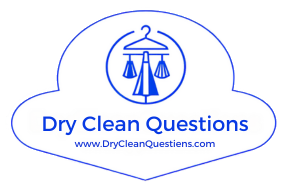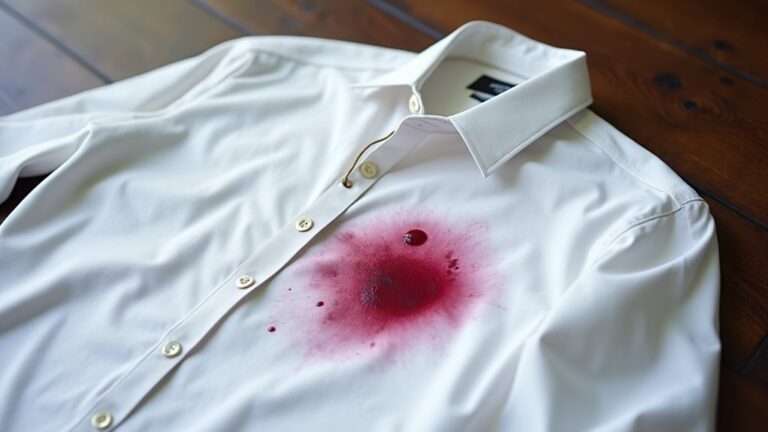Dry cleaning isn’t completely dry, and here’s the thing that confused me for years – it’s called “dry” because it uses chemical solvents like perchloroethylene instead of water, not because your clothes emerge bone-dry. The solvents effectively dissolve oil-based stains that water can’t tackle, while protecting delicate fabrics from the swelling and distortion that traditional washing causes. Your garments might feel slightly damp afterward since moisture plays a supporting role in the process, and there’s much more happening behind those machines.
What Does “Dry” Actually Mean in Dry Cleaning
When I first heard the term “dry cleaning” as a kid, I imagined some magical process where clothes got cleaned without any liquid at all—maybe brushed with special powders or zapped with mysterious rays that made stains disappear. 😅
As a kid, I thought dry cleaning involved magical stain-zapping rays instead of actual liquid solvents. 😅
What I didn’t realize then, and what might surprise you now, is that dry cleaning isn’t actually dry in the way we typically think about it.
The “dry” in dry cleaning simply means it doesn’t use water, which can wreak havoc on delicate fabrics like silk and wool. Instead, this cleaning process relies on dry cleaning solvents—liquid chemicals that effectively remove stains without causing shrinkage or distortion.
These solvents excel at tackling oil-based stains that water-based cleaning methods often struggle with, making each cleaning cycle remarkably effective for preserving your most precious garments.
The most commonly used solvent is perchloroethylene, though many cleaners are now switching to newer eco-friendly alternatives that are safer for both the environment and human health.
Chemical Solvents Replace Water in the Process
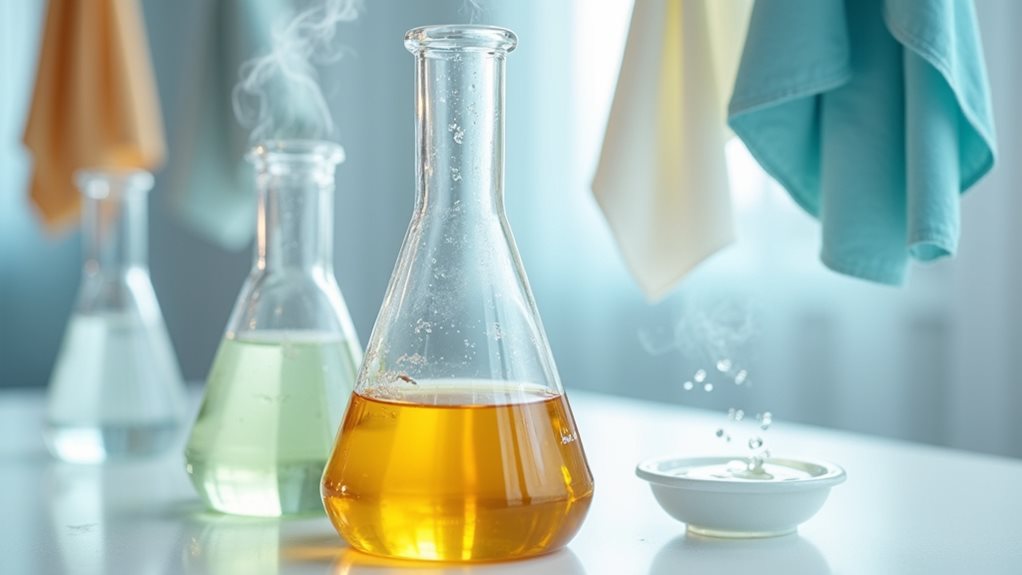
Although the dry cleaning industry has mastered the art of making this process seem mysterious, the reality is surprisingly straightforward: powerful chemical solvents do all the heavy lifting that water would normally handle in your washing machine.
Instead of soaking your favorite silk blouse in H2O, dry cleaning chemicals like perchloroethylene work their magic on stubborn stains that would laugh at your home laundry attempts. The dry cleaning solvent literally replaces water throughout the entire cleaning process, which explains why delicate fabrics emerge unscathed from their chemical bath.
These petroleum-based solvents excel at dissolving oil-based messes—think salad dressing disasters or makeup mishaps—that regular water can’t touch. The solvents used in the dry cleaning process are specifically chosen because they’re gentle on fabrics while being ruthless against stains. Modern dry cleaners are increasingly adopting hydrocarbon or silicone-based alternatives as safer substitutes for traditional perchloroethylene solvents.
Why Traditional Water Washing Damages Certain Fabrics
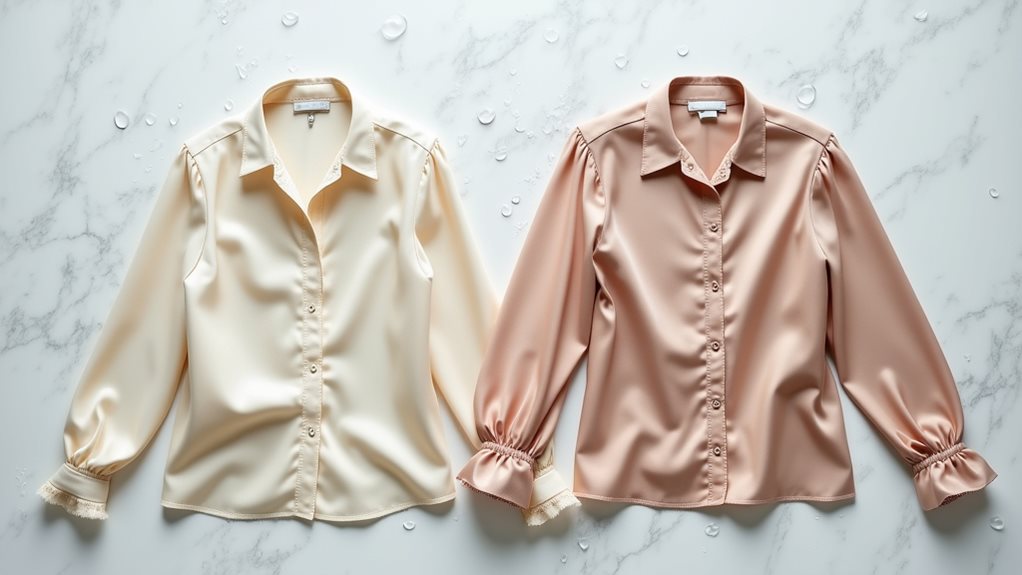
When you toss your favorite wool sweater into the washing machine, you’re fundamentally asking those natural fibers to drink up water like a sponge, which causes them to swell and lose their original shape—trust me, I learned this the hard way with a cashmere scarf that turned into doll clothes 😅.
Your delicate silk blouses and vintage fabrics face a similar fate because water creates stress on their fragile structure, leading to distortion that no amount of careful stretching can fix.
Plus, if you’ve ever tried scrubbing out an oil stain with soap and water, you’ve probably noticed how those greasy spots just laugh at your efforts, since water and oil repel each other like awkward teenagers at a school dance.
This is exactly why professional dry cleaning uses specialized chemical solvents instead of water to break down stubborn stains without damaging delicate materials.
Water Causes Fiber Swelling
The culprit behind countless ruined sweaters and misshapen silk blouses isn’t your washing machine’s spin cycle or that extra scoop of detergent you thought would help – it’s actually the water itself, which acts like a tiny army of moisture molecules that invade delicate fabrics and cause them to swell beyond their intended size.
When water causes fiber swelling in materials like silk, wool, or rayon, you’re fundamentally watching your garment’s original properties transform before your eyes 😬. The mechanical agitation only makes things worse, stretching those swollen fibers into new, unwanted shapes.
That’s why dry cleaning better preserves delicate fabrics – the cleaning process skips water entirely, preventing garment damage while maintaining the structure you paid good money for.
Instead of water, dry cleaning relies on chemical solvents like perchloroethylene that can effectively dissolve oil-based stains without causing the fiber damage that water would create.
Delicate Fabrics Risk Distortion
While many of us learned the hard way that certain fabrics simply can’t handle traditional washing, understanding exactly why delicate materials like silk, wool, and rayon become victims of water damage can save you from future fashion disasters.
When water penetrates these delicate fabrics, it causes fibers to swell and stretch beyond their natural limits, creating permanent distortion that no amount of careful ironing can fix. Your favorite silk blouse might emerge from water washing looking more like a funhouse mirror reflection of its former self 😅
The mechanical action weakens these sensitive materials, making them lose their original qualities and lustrous finish. That’s why choosing the right cleaning method matters – dry cleaning can effectively remove stains without the destructive effects of traditional water-based processes.
Dry cleaning uses chemical solvents instead of water to remove dirt and stains while preserving the fabric’s integrity, shape, and texture.
Non-Polar Stains Resist Water
Envision this scenario: you’re frantically scrubbing that stubborn grease stain from your favorite shirt with soap and water, watching in frustration as it seems to mock your efforts by refusing to budge even slightly.
Here’s the scientific truth behind your struggle—non-polar stains like oil and grease simply don’t dissolve in water, no matter how much elbow grease you apply.
Think of it like trying to mix oil and vinegar; they’ll always separate because they’re chemically incompatible.
That’s where dry cleaning machines become your savior, using specialized solvents instead of water and air to tackle these stubborn spots.
The cleaning process targets what water can’t touch, then they remove the solvent completely, leaving your delicate fabrics pristine without moisture damage.
These chemical solvents include perchloroethylene as well as newer eco-friendly alternatives like hydrocarbon or silicone-based cleaners that effectively break down oil-based stains.
The Role of Moisture During Solvent-Based Cleaning
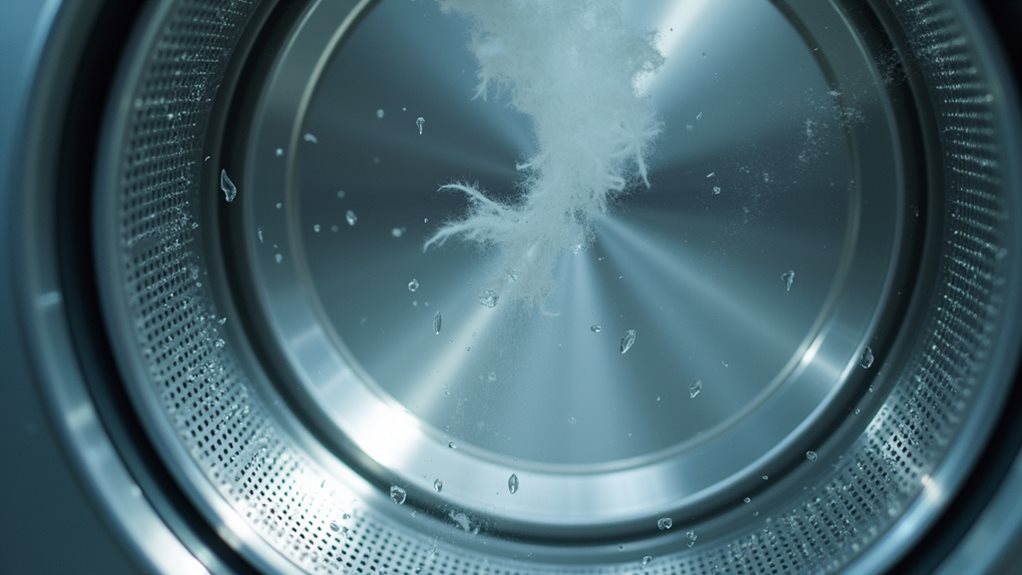
Although dry cleaning earns its name from the absence of water as the primary cleaning agent, you’d be surprised to learn that moisture still plays a fascinating supporting role in this seemingly waterless process.
When I first discovered this, I felt like I’d been living a lie! 😅 The liquid solvents used in dry cleaning actually contain trace amounts of moisture that improve the cleaning process by helping dissolve stubborn oils and grease more effectively.
During the rinse cycle, freshly distilled solvent with minimal moisture assists in stain removal, while the drying phase introduces small amounts of moisture to reduce static and restore fabric texture.
Modern solvent recovery systems guarantee this moisture gets recycled, minimizing environmental impact while maximizing cleaning efficiency.
Before the cleaning cycle begins, garments undergo inspection and pre-treatment of stains to ensure the best possible results when placed in the solvent-based machine.
How Garments Feel After Professional Dry Cleaning
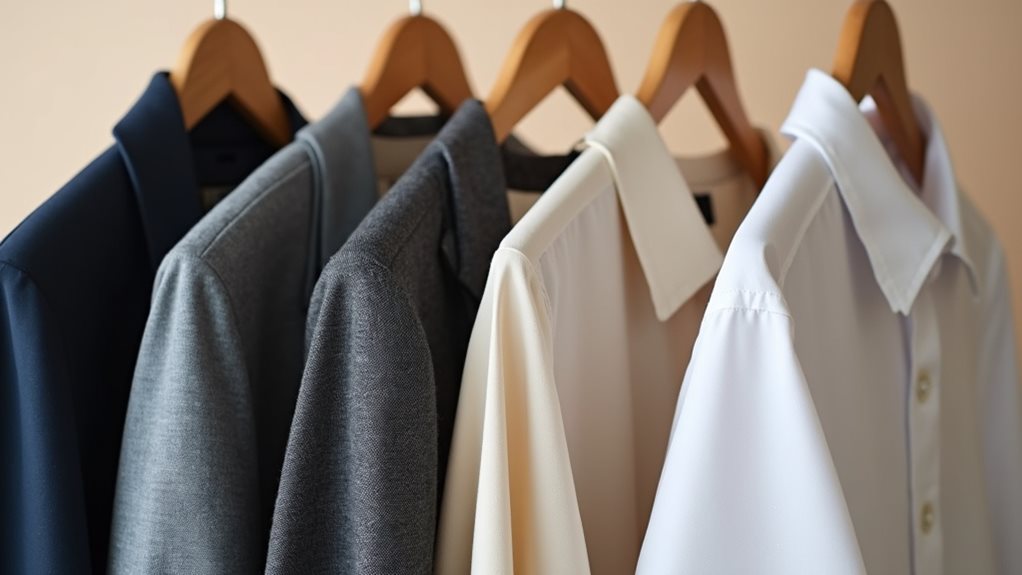
When you slip on a freshly dry-cleaned garment for the first time, there’s an unmistakable transformation that goes beyond just cleanliness—it’s like your favorite outfit got a complete spa treatment!
Professional dry cleaning leaves garments cleaned with a crisp, weightless feel that honestly makes me wonder why I ever thought my washing machine was enough. The absence of water means your silk blouse maintains its original texture, while those stubborn oil-based stains vanish completely.
You’ll notice how the cleaning agents create this pleasant scent that’s fresh without being overwhelming—none of that musty smell water sometimes leaves behind.
It’s fascinating how garments cleaned through this process feel simultaneously lighter yet more substantial, like they’ve been restored to their true potential. The chemical solvents used in dry cleaning, such as perchloroethylene or eco-friendly alternatives, are specifically designed to dissolve oils and grease that water-based washing simply cannot tackle effectively.
Common Misconceptions About the Dryness of Dry Cleaning
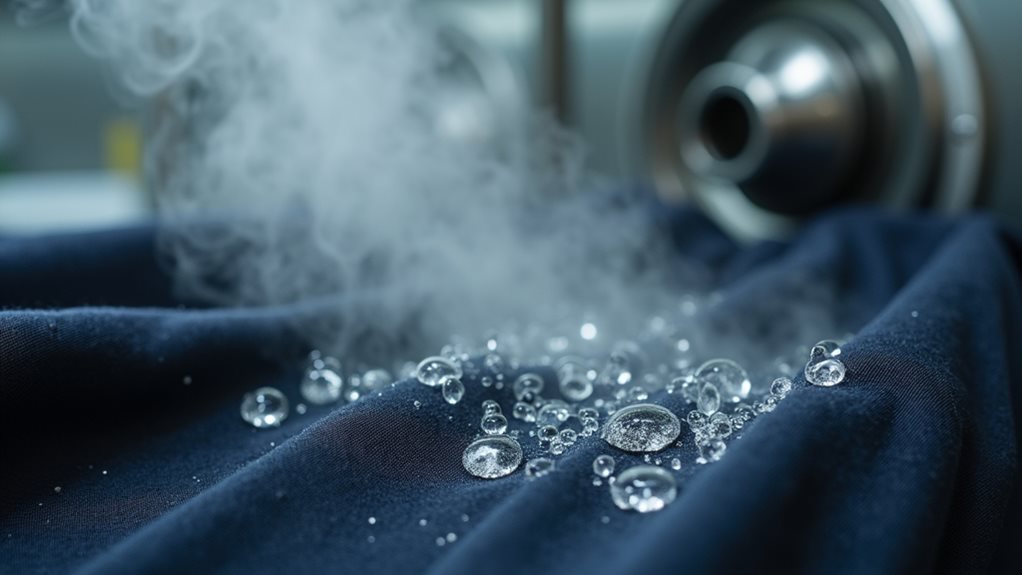
You’ve probably wondered why it’s called “dry” cleaning when your clothes clearly get treated with some kind of liquid, and honestly, I used to think the same thing until I learned that the name comes from the absence of water, not the complete absence of moisture.
The process actually involves tumbling your garments in chemical solvents like perchloroethylene, which means your favorite silk blouse is getting a thorough liquid bath, just not the kind you’d expect.
What makes it seem “dry” is the final step where heated air evaporates every trace of solvent, leaving your clothes feeling crisp and ready to wear, though they’ve been anything but dry during the actual cleaning process.
This method is particularly important for delicate fabrics that would suffer shrinkage or color bleeding if exposed to water and traditional washing methods.
“Dry” Name Origin
If you’ve ever wondered why they call it “dry” cleaning when your clothes clearly get dunked in liquid, you’re not alone in scratching your head over this confusing terminology.
The name actually dates back to when dry cleaners began using petroleum-based solvents instead of water, which felt revolutionary compared to traditional washing methods.
In the early days of dry cleaning, this cleaning service seemed magical because clothes are cleaned without that familiar soaking-wet feeling you’d expect.
The “dry” label stuck because the liquid solvent evaporates much faster than water, leaving fabrics feeling relatively dry.
Today’s environmentally friendly solvents continue this tradition, and while cleaning is a process involving liquids, the quick-drying nature earned its misleading but enduring name.
Modern dry cleaning typically uses chemical solvents like perchloroethylene or newer eco-friendly alternatives that can dissolve oils and grease more effectively than water-based washing methods.
Liquid Solvents Used
The biggest misconception people have about dry cleaning isn’t just the name—it’s thinking that your clothes somehow magically get clean without any liquid touching them at all, which honestly sounds like something out of a fairy tale when you really think about it.
Your dry cleaned garments are actually soaked in liquid solvents, primarily perchloroethylene (perc), which work incredibly well at dissolving oils and grease that water simply can’t touch.
These specialized solvents make the cleaning process so effective because they’re non-polar, meaning they can grab onto stubborn stains that would laugh at regular detergent.
The machines constantly recirculate these liquid solvents, proving that “dry” cleaning is really just “water-free” cleaning—still very much a wet process! 😊
Moisture Removal Process
While many people assume their clothes emerge bone-dry from the cleaning process, the reality is that dry cleaning involves a careful moisture removal dance that’s more nuanced than most folks realize.
Your garments actually go through multiple stages to achieve that crisp, fresh finish you love. During the drying process, machines tumble clothes in warm air to eliminate most solvent, though some residual moisture typically lingers—and that’s completely normal.
Here’s what happens during moisture removal:
- Solvent extraction removes the bulk of cleaning fluids from fabric fibers
- Warm air circulation helps evaporate remaining moisture during tumbling cycles
- Temperature control keeps solvents at 30°C or lower for ideal results
- Final pressing adds strategic heat and steam to eliminate stubborn wrinkles
- Quality checks confirm garments meet dryness standards before you pick them up
